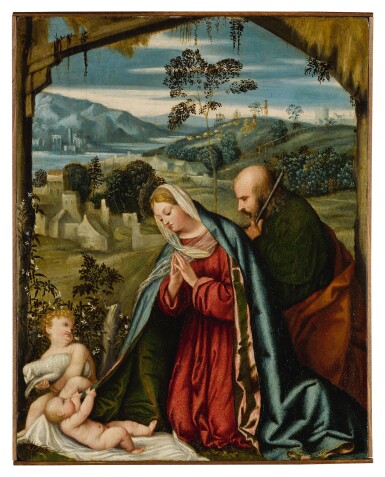
Property from a Distinguished Private Collection
Alessandro Bonvicino, called Moretto da Brescia
The Holy Family in a landscape
Lot Closed
January 30, 03:13 PM GMT
Estimate
150,000 - 200,000 USD
Lot Details
Description
Property from a Distinguished Private Collection
Alessandro Bonvicino, called Moretto da Brescia
Brescia circa 1498 - 1554
The Holy Family in a landscape
oil on panel
panel: 17 1/8 by 13 3/8 in.; 43.5 by 34 cm.
framed: 23 1/2 by 19 1/2 in.; 59.7 by 49.5 cm.
Possibly Lutomirski collection, Milan1;
Anonymous sale (Private collector, who purportedly acquired at above sale in 1933), New York, Christie's, 24 January 2003, lot 29 (as Francesco Prata da Caravaggio);
There acquired.
B. Maria Savy, in The Alana Collection: Italian Paintings From the 14th to 16th Century, Florence 2014, vol. 3, pp. 10-12, cat. no. 2, reproduced.
Alessandro Ballarin was the first to correctly re-attribute this elegant Adoration to the young Moretto da Brescia. Ballarin has reconstructed the earliest activity of the artist, which centers around the commission of the organ doors depicting Saint Faustinus and Saint Jovita for the old cathedral of Brescia in 1515 (now in the church of Santa Maria in Valvendra in Lovere).
Moretto da Brescia was greatly inspired by fellow Brescian Girolamo Romani, called Romanino (circa 1485-1566), with whom scholars believe he traveled to Padua in 1513-1514. Moretto likely then went on to Venice, as many of his paintings from 1514-1515 (including the present example) bear the influence of the great Venetian painters working in the wake of Giorgione, including the young Titian and Palma Vecchio. The Adoration presented here can be dated to around 1515 and compared directly with the Madonna and Child now in the Pushkin Museum (inv. no. 106). Interestingly, the unique framing device of the beams of the shed within the composition reflect an understanding of the Northern Renaissance master Albrecht Dürer, though the central theme of the Holy Family derives more from Venetian influences.
1. Ballarin saw a photograph of the painting in the dealer Harry Solomon's office in Milan in 1989 with the Lutomirski provenance; it is not evident that the painting exchanged hands at that time as the consignor of the painting to the 2003 auction acquired it at the 1933 auction.
